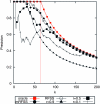Increasing power of genome-wide association studies by collecting additional single-nucleotide polymorphisms
- PMID: 21467568
- PMCID: PMC3122306
- DOI: 10.1534/genetics.111.128595
Increasing power of genome-wide association studies by collecting additional single-nucleotide polymorphisms
Abstract
Genome-wide association studies (GWASs) have been effectively identifying the genomic regions associated with a disease trait. In a typical GWAS, an informative subset of the single-nucleotide polymorphisms (SNPs), called tag SNPs, is genotyped in case/control individuals. Once the tag SNP statistics are computed, the genomic regions that are in linkage disequilibrium (LD) with the most significantly associated tag SNPs are believed to contain the causal polymorphisms. However, such LD regions are often large and contain many additional polymorphisms. Following up all the SNPs included in these regions is costly and infeasible for biological validation. In this article we address how to characterize these regions cost effectively with the goal of providing investigators a clear direction for biological validation. We introduce a follow-up study approach for identifying all untyped associated SNPs by selecting additional SNPs, called follow-up SNPs, from the associated regions and genotyping them in the original case/control individuals. We introduce a novel SNP selection method with the goal of maximizing the number of associated SNPs among the chosen follow-up SNPs. We show how the observed statistics of the original tag SNPs and human genetic variation reference data such as the HapMap Project can be utilized to identify the follow-up SNPs. We use simulated and real association studies based on the HapMap data and the Wellcome Trust Case Control Consortium to demonstrate that our method shows superior performance to the correlation- and distance-based traditional follow-up SNP selection approaches. Our method is publicly available at http://genetics.cs.ucla.edu/followupSNPs.
Figures














Similar articles
-
Efficient association study design via power-optimized tag SNP selection.Ann Hum Genet. 2008 Nov;72(Pt 6):834-47. doi: 10.1111/j.1469-1809.2008.00469.x. Epub 2008 Aug 13. Ann Hum Genet. 2008. PMID: 18702637 Free PMC article.
-
Power-based, phase-informed selection of single nucleotide polymorphisms for disease association screens.Genet Epidemiol. 2006 Sep;30(6):459-70. doi: 10.1002/gepi.20159. Genet Epidemiol. 2006. PMID: 16685721
-
Enhanced statistical tests for GWAS in admixed populations: assessment using African Americans from CARe and a Breast Cancer Consortium.PLoS Genet. 2011 Apr;7(4):e1001371. doi: 10.1371/journal.pgen.1001371. Epub 2011 Apr 21. PLoS Genet. 2011. PMID: 21541012 Free PMC article.
-
Tag SNP selection for association studies.Genet Epidemiol. 2004 Dec;27(4):365-74. doi: 10.1002/gepi.20028. Genet Epidemiol. 2004. PMID: 15372618 Review.
-
Reducing GWAS Complexity.Cell Cycle. 2016;15(1):22-4. doi: 10.1080/15384101.2015.1120928. Cell Cycle. 2016. PMID: 26771711 Free PMC article. Review.
Cited by
-
Enhanced methods to detect haplotypic effects on gene expression.Bioinformatics. 2017 Aug 1;33(15):2307-2313. doi: 10.1093/bioinformatics/btx142. Bioinformatics. 2017. PMID: 28369161 Free PMC article.
-
Colocalization of GWAS and eQTL Signals Detects Target Genes.Am J Hum Genet. 2016 Dec 1;99(6):1245-1260. doi: 10.1016/j.ajhg.2016.10.003. Epub 2016 Nov 17. Am J Hum Genet. 2016. PMID: 27866706 Free PMC article.
-
Dissecting the genetics of complex traits using summary association statistics.Nat Rev Genet. 2017 Feb;18(2):117-127. doi: 10.1038/nrg.2016.142. Epub 2016 Nov 14. Nat Rev Genet. 2017. PMID: 27840428 Free PMC article. Review.
-
Widespread Allelic Heterogeneity in Complex Traits.Am J Hum Genet. 2017 May 4;100(5):789-802. doi: 10.1016/j.ajhg.2017.04.005. Am J Hum Genet. 2017. PMID: 28475861 Free PMC article.
-
DISSCO: direct imputation of summary statistics allowing covariates.Bioinformatics. 2015 Aug 1;31(15):2434-42. doi: 10.1093/bioinformatics/btv168. Epub 2015 Mar 24. Bioinformatics. 2015. PMID: 25810429 Free PMC article.
References
-
- Cousin E., Genin E., Mace S., Ricard S., Chansac C., et al. , 2003. Association studies in candidate genes: strategies to select SNPs to be tested. Hum. Hered. 56: 151–159 - PubMed
-
- de Bakker P. I. W., Yelensky R., Pe’er I., Gabriel S. B., Daly M. J., et al. , 2005. Efficiency and power in genetic association studies. Nat. Genet. 37: 1217–1223 - PubMed
Publication types
MeSH terms
Grants and funding
LinkOut - more resources
Full Text Sources
Research Materials

